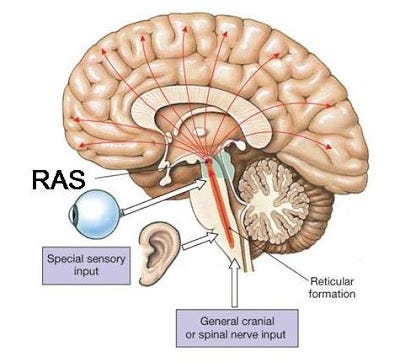|
Within the intricate web of the central nervous system (CNS) lies a remarkable structure known as the reticular activation system (RAS). If you’ve had a craniosacral appointment with me, you may have heard me mention this system. I often work with the RAS to help the body break free of stress or when releasing trauma from the body. By calming this relay station, you can help lower the body’s stress response and bring about a sense of calm and a feeling of being yourself again. Despite its small size, the RAS plays a huge role in regulating our consciousness, attention, and alertness. In this blog post, I will explore the function and location of the RAS and shed light on how it influences our daily lives. The reticular activation system is a complex network of nuclei and fibers located in the brainstem, extending from the upper part of the spinal cord to the thalamus. It consists of the reticular formation, a collection of interconnected nuclei involved in various brain functions. One of the primary functions of the RAS is to regulate our state of consciousness. It acts as a gatekeeper, filtering sensory information and determining the level of wakefulness and alertness. When the RAS is active, it allows relevant sensory stimuli to reach the cerebral cortex, resulting in our conscious awareness of the surrounding environment. Conversely, when the RAS is less active, such as during sleep or sedation, it restricts the flow of sensory information, leading to altered states of consciousness. The RAS plays a crucial role in modulating attention and alertness. It receives input from various sensory sources, including visual, auditory, and tactile stimuli, and directs this information to the appropriate brain regions. By influencing the activity of the thalamus, the RAS regulates the flow of sensory information, allowing us to focus on relevant stimuli while filtering out irrelevant ones. A well-functioning RAS promotes optimal attention, concentration, and cognitive performance. The RAS is intricately involved in regulating the sleep-wake cycle. It interacts with other brain structures, including the pineal gland and the suprachiasmatic nucleus (part of the circadian rhythm function and production of melatonin), to coordinate transitions between wakefulness and sleep. During wakefulness, the RAS is active, promoting alertness and vigilance. As we prepare for sleep, the RAS gradually decreases its activity, allowing for rest and restoration. Disruptions in the RAS can lead to sleep disturbances, such as insomnia or excessive daytime sleepiness. The RAS and Daily Life: The reticular activation system is a vital component of the CNS that regulates consciousness, attention, alertness, and sleep-wake cycles. Its functions permeate our daily lives, impacting our ability to stay focused, remain alert, and experience optimal wakefulness and sleep. Understanding the role of the RAS helps us appreciate its significance in our overall well-being and highlights the importance of maintaining a healthy and balanced system. Continued research into the reticular alarm system promises to unravel further mysteries and contribute to our understanding of the human brain's incredible complexity. It also helps researchers and healthcare professionals develop strategies for diagnosis, treatment, and management of conditions that involve the RAS.
0 Comments
Leave a Reply. |
What is self-care?
|
What Our Clients Are Saying"Janet is an incredibly gifted healer. She does life-changing bodywork. I can’t recommend her highly enough." Facebook Recommendation |
Contact UsTwin Cities CranioSacral
Janet Crow MS, CMT, CST-T 557 West 7th Street Saint Paul, MN 55102 (612) 444-6494 [email protected] |

 RSS Feed
RSS Feed